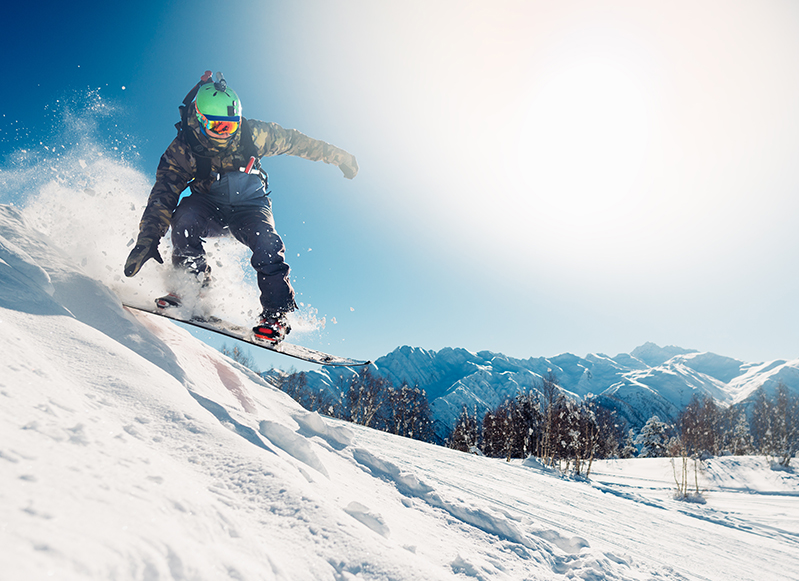Many Las Vegas locals indulge in winter sports during wintertime. However, thousands of people throughout the U.S are treated at ERs and doctors’ clinics for skiing, ice-skating, snowboarding and other sports-related injuries. At Advanced Manual Therapy in Las Vegas we always stress the safety aspect in sports. There are certain steps you can take to reduce the chances of injuries.
For a large majority of Las Vegas locals, winter sports such as snowboarding, sledding, and skiing. become the perfect escape from the hot desert. They hit the slopes for some much-needed respite from the sun and heat. As experienced Las Vegas physical therapists,we always encourage people to focus on being as active as possible.
Most people can avoid common injuries and strains when doing sports by routinely strengthening, exercising, and using the right gear and proper technique. However, overexerting yourself while participating in these activities can easily lead to injuries. It’s never a good idea to push your limits especially when you are excessively tired or in pain.
That puts you atincreased risk of dislocations, fractures, sprains, and strains due to exhaustion. All of these problems are avoidable if you focus on being active right through the year and listen to your body.
Some Common Winter-Sports Injuries
Different injuries can happen while participating in various winter sports. The commonest ones are dislocations, fractures, sprains, and strains. However, every sport comes with its specific set of risks.
The most common injuries happen to the knees of skiers. Ice skaters typically suffer concussions while snowboarders tend to injure their wrists. Ingeneral, snowboarders hurt their upper body, skiers hurt their knees and legs, and ice skaters generally hurt their head.
Skiing is one of the most dangerous snow sports, while snow tubing is typically the safest. However, in reality, an individual could suffer a traumatic brain injury simply from slipping on some ice. Rather than restrict your recreational activities, it’s better to take steps to reduce the associated risks.
Winter Sports Safety Tips From The Physical Therapy Institute In Las Vegas
While winter sports are seasonal, staying active and conditioned throughout the year are important aspects of staying safe on the slopes. Regardless of the sport, you want to participate in, 30 minutes of stretching and exercise every day will significantly decrease the risk for various injuries.
Winter Sports Safety Precautions
Wear Safety Guards
- Wrist guards, gloves, padding, gloves, kneepads, andhelmets are some of the safety guards you need to be using. In addition, make sure that you wear multiple layers of wind and water-resistant clothing. Warm socks and ankle-supporting gear are some of the other safety guards you should wear.
Don’t Exhaust Yourself Excessively
- DMost injuries occur later in the evening when people have been on the slopes all day and are extremely tired. So ensure you catch some rest intermittently and don’t push yourself beyond your limits.
Go With Company
- It’s never a good idea to participate in any winter sport alone. This is especially true if you’re in isolated spots. Always have someone with you when you are on the slopes. Similarly, it’s best to stay within the designated areas of your resort. Smaller slopes and remote areas can have a number of unforeseen dangers.
Professional Lessons
- This is something beginners should never omit. Learning the right techniques can go a long way in preventing injuries later. If you have planned a trip and are planning to participate in some winter sports, it’s a good idea to take professional lessons in advance.
Don’t Attempt To Fight The Fall
- It’s vital that you allow the momentary failure of volitional control to take over and fall if you lose balance while on the slopes. The commonest reflex people have is that they lock their arms and try to break their fall with their wrists and hands. It’s far better to use your forearms to absorb the impact of the fall and rather than leaning forward, sit back when possible.
Be Aware When You’re Sledding
- Most snow sports like ice skating, snowboarding and skiing require you to be at professionally operated rinks or resorts. However, sledding is an activity that can be done in any snowy area. While most people find the versatility of sledding very appealing, that’s one of the aspects, which makes it riskier.
- It’s best to use a sled that has a steering function and unless the area is well illuminated, never go headfirst. Although it may be tempting to use plastic sheets or garbage bags to sled on, this isn’t something we recommend. Sharp objects on the slopes can pierce you and cause injury.
Be Cautious
- It’s important that everyone, including experienced participants,be cautious. Even if you are a seasoned ice skater, snowboarder or skier, don’t forget that you too are susceptible to injuries. Being overconfident can cause you to neglect using proper safety guards, push your limits and allow your attention to wander. No matter how adept you are, it’s important that you don’t lose sight of the basics of safety on the slopes.
Following these safety tips can go a long way inreducing your risk for winter sport-related injuries this year. For any more information, feel free to contact the experts at Advanced Manual Therapy Institute Las Vegas.

